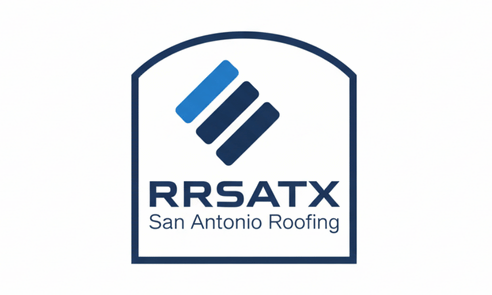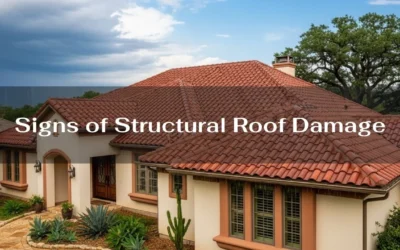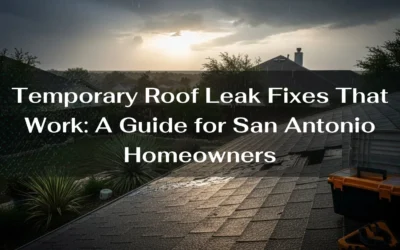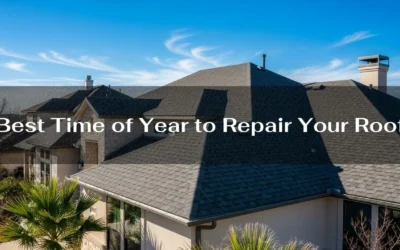Yes, in many cases, you can absolutely repair a roof without replacing the entire thing. For localized issues like a few missing shingles or a minor leak, a professional repair is often the most sensible and cost-effective solution, especially if the rest of your roof is in good structural condition.
The decision to repair instead of replace ultimately depends on the age of your roof, the type and extent of the damage, and your budget. A targeted repair can extend the life of your roof for many years, saving you from the significant expense of a premature replacement.
Choosing to repair your roof is an excellent option when the problem is isolated and the overall roofing system is still healthy. Here are the most common scenarios San Antonio homeowners face where a repair is the best call:
- Localized Storm Damage: Texas storms can be fierce. It’s common for high winds to lift and remove a few shingles or for small hail to damage a specific section. If the damage is contained to one area, a roofer can replace the affected shingles and ensure the underlayment is intact.
- Minor Leaks Around Vents or Flashing: The most common sources of leaks are not the shingles themselves, but the seals around roof penetrations, such as pipes, vents, chimneys, and skylights. The flashing or sealant in these areas can degrade over time under the intense San Antonio sun. These are typically straightforward and affordable repairs.
- The Roof is Relatively New: If your roof is under 15 years old and has been well-maintained, it likely has many years of life left. Opting for a repair to fix a minor issue is a smart way to maximize your initial investment.
Warning Signs: When a Repair Isn’t Enough
While repairs are often sufficient, sometimes they are only a temporary fix for a much larger problem. Pushing for a repair when a replacement is needed can lead to more significant and expensive damage down the road. Here are signs that you should lean towards a complete replacement:
- Widespread Granule Loss: If you see a large amount of shingle granules (they look like coarse black sand) in your gutters, it means the protective layer of your shingles is wearing away across the entire roof. This leaves them brittle and vulnerable.
- The Roof’s Age: An asphalt shingle roof in San Antonio typically lasts 20-25 years. If your roof is reaching or has surpassed this age, its materials are likely at the end of their functional life. A leak is often the first sign of systemic failure.
- Multiple Leaks or Extensive Water Damage: One small leak is repairable. Numerous leaks in different areas of your home are a clear indicator that the entire roofing system is failing. Similarly, if an inspection reveals soft, sagging spots on the roof deck, it means water has been getting through for a while, and a simple patch won’t fix the rotted wood underneath.
- Curling, Cracking, or Bald Shingles: If you look at your roof and see that many shingles are curling at the edges, have significant cracks, or have large “bald” patches with no granules, the roof is no longer effectively protecting your home.
The Bottom Line: An Ounce of Prevention
For San Antonio homeowners, the key is a professional assessment. A qualified roofing contractor can provide an honest evaluation of your roof’s condition, helping you understand whether a simple, targeted repair will suffice or if a full replacement is the wiser long-term investment to protect your home.
Frequently Asked Questions (FAQ)
Q: How long does a typical roof repair last?
A: A professional roof repair should last for the remaining lifespan of your existing roof. When a licensed contractor uses quality materials that match your current shingles, the patch becomes an integral and durable part of the overall roofing system.
Q: Can you replace just one section of a roof?
A: Yes, it’s possible to replace a single section or slope of a roof. This is a standard solution after isolated storm damage. However, it can be not easy to get a perfect color match if the existing shingles have faded from the sun over time.
Q: Is it okay to put new shingles over old ones?
A: While some local codes may permit one layer of shingles to be installed over an existing layer (a “roof-over”), it is generally not recommended in San Antonio. This practice can conceal underlying damage to the roof deck, add significant weight, and trap heat, thereby shortening the life of the new shingles.
Q: What happens if I don’t fix a small roof leak?
A: Ignoring a small leak is a costly mistake. Over time, that “small” leak will lead to rotted wood decking, saturated insulation, mold and mildew growth in your attic, and eventually, significant damage to your interior ceilings and walls.










